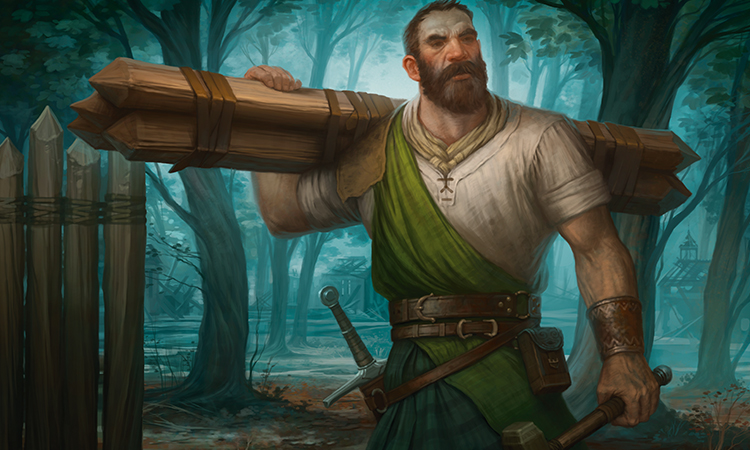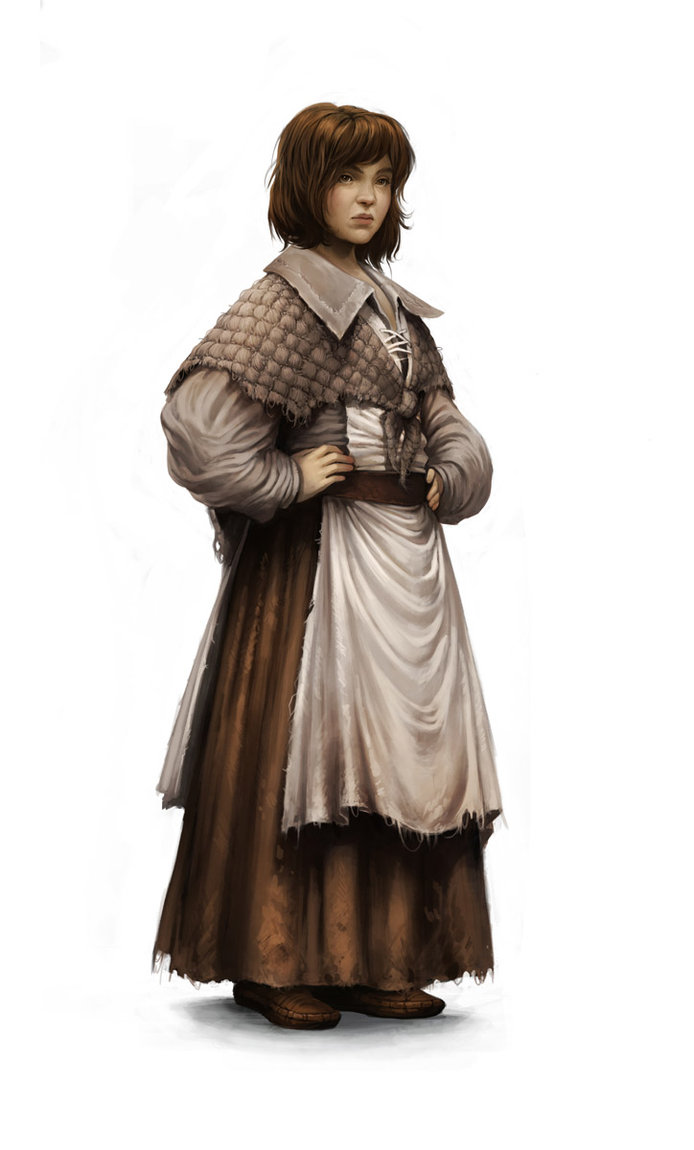Human
Humans, also referred to as the race of Man or Mankind, or collectively as Humanity, are the most prolific of the intelligent species on the planet. They inhabit every continent to some degree, although their grand empires are localized to Centerra, Meridos, and Ostara, with smaller populations on Septenn, Vesteria, and assorted small islands, some of which are yet to be discovered by scholars. There are many different ethnic groups within the human race, including Centerran , Meridor, Ostaran, and the Northmen, who descended from Centerran colonists on Septenn. Humans tend to behave in quite an imperialistic manner, and have a tendency to attempt the manipulation or conquest of other intelligent species, and even different human ethnicities.
Basic Information
Anatomy
Humans are generally upright in stature; they possess four limbs, the hind two of which are positioned directly underneath the body and used for locomotion. Evolving to stand upright has altered the orientation of the pelvis and genitalia compared to most mammals. The two forelimbs are equipped with manipulatory hands, possessing opposable thumbs, which allow them to accomplish a great many tasks, some requiring very precise and delicate motor skills. Each hand and foot possess five digits, each rounded and equipped with a hard, keratinous nail. Walking upright and having versatile arms gives them seemingly broader chests than most other animals; on their chests, both sexes possess nipples, but only the females use theirs to nourish infants. Both the body and the details of the face tend to be bilaterally symmetrical down the middle.
Biological Traits
Humans are warm-blooded mammals (primates, specifically) with opposable thumbs, extreme tool-making capability, and brains that can develop language, creative technical and artistic works, as well as complex social structures. They stand upright in a plantigrade stance and possess five digits at the end of each limb with keratinous nails instead of claws.
Genetics and Reproduction
Human reproduction is much like that of other mammals. Upon fertilization, the female carries, on average, one to two children for roughly 9 months before being born. Given that a human child's head is large compared to its body, birth can be a difficult, and undoubtedly painful, experience for the mother. After birth, the baby's umbilical cord, now useless, dries up and falls off or is cut off.
Growth Rate & Stages
Human children grow quickly; while different societies have different starting points for "adulthood", humans become sexually mature between the ages of 13 and 15, have usually reached full physical development by age 20, and full mental development between the ages of 21 and 25. Humans start to feel the effects of aging by their 40s or 50s, and enter into a period referred to as "middle age". Their hair begins losing color and turning grey, their skin loses elasticity, muscles decrease in strength and mass, bones may become more fragile, and females lose their reproductive abilities. By about the age of 70, they are considered elderly. If properly cared for, humans have the potential to live past the ages of 80, 90, and even 100 years, though in a ruthless environment like Vesteria, the average lifespan is about 65.
Ecology and Habitats
Though originally adapted to plains environments, humans are extremely adaptable and intuitive, allowing them to survive, if not thrive, in just about any habitat imaginable.
Dietary Needs and Habits
With a vast system of agriculture and animal husbandry, a human has access to just about any diet they wish, though most prefer a well-balanced omnivorous one.
Additional Information
Social Structure
Depending on the society in which humans live, their social roles can vary greatly. Among the humans of Centerra, a patriarchal society pervades; for women to do anything except housework, farming, and raising children tends to make waves. The men of the southern continent of Meridos have awarded their women a bit more autonomy, allowing them to become warriors and leaders should they so choose; however, unless they prove themselves in combat, women are still looked down upon as inferior to men. A similar culture pervades in Ostara, but the human colonists of Septenn appear to have bucked this trend completely, allowing women to perform nearly all of the roles in society that men do, and awarding them much of the same rights.
Thus far, the human settlers of Vesteria don't seem to have established that element of their culture yet; time will tell how women will be treated in these colonies, but seeing the number of female explorers heading inwards towards Vesteria's vast woodlands, things could be quite different here than on the Centerran motherland.
Facial characteristics
Humans can vary greatly in their facial structure and appearance; most tend to have evenly proportioned ears, noses, lips and eyes. Cheek bones and chin may or may not be prominent. Males tend to have facial hair beginning in adolescence.
Geographic Origin and Distribution
Native to Centerra, Meridos, and Ostara, the great human civilizations have now begun to colonize the other continents as well, namely Septenn and Vesteria.
Average Intelligence
Humans are highly intelligent, and have built a number of grandiose civilizations, with advances in knowledge and technology occurring regularly.
Perception and Sensory Capabilities
On average, humans have below average abilities in most senses: while their skin is extremely sensitive to touch, even to minute disturbances, they have much fewer tastebuds than most other animals, their hearing isn't extraordinarily keen, their noses have little to no use in tracking scents, and their eyesight is only reliable during the daytime and up to about 1 kilometer (0.62 miles) away.
Symbiotic and Parasitic organisms
Humans, being highly intelligent, have domesticated several animals for food, work, and play to make their lives easier, though this technically is not symbiosis. Humans can become infected with a number of harmful or deadly parasites, often transmitted by animals or through infected food or water.
Civilization and Culture
Major Organizations
- The Goldmont Empire -- The largest human civilization and the sole occupier of the continent of Centerra.
- The Chiefdoms of Meridos -- Various tribal lineages share the southern continent, sometimes peacefully, more often violently.
- The Jade Confederacy -- Also called the Jade Alliance. The warlords of Ostara agreed to a lasting peace 100 years ago (so far, so good) in order to advance their peoples' ambitions. They are now the penultimate military power in the east, though they only use their strength in self-defense.
- The United Jarldoms of Septenn -- Similar to the pact formed by the eastern warlords, only smaller and far more temporary. The leaders of the typically feuding jarldoms have a pact in place allowing all clans to band together as one nation in the face of a large, shared threat. The Unity Pact has, thus far, only ever been used once... but the ambitions of the Goldmont Empire may cause it to take effect again.
Beauty Ideals
In general, human males , consciously or not, seek women whose bodies show signs of health and fitness for child-rearing: large breasts, wide hips, and heathy skin and hair. Females, likewise, tend to favor males who would be a good protector and provider for their future family, someone with muscles, a strong jaw, and a testosterone-driven urge to compete with other males.
Gender Ideals
Males consider themselves to be leaders, warriors and hard workers, whereas females are often relegated to housework, cooking, and child-rearing, though occasionally, these roles can be switched or broken altogether. Some human populations are more accepting of this than others.
Courtship Ideals
Humans tend to marry for love, but arranged marriages, especially political ones, are also quite common. Generally, humans prefer a level of personal intimacy with their potential mates, getting to know them as friends first before committing to anything else. The customs of courtship and marriage beyond this, however, vary greatly from culture to culture.
Relationship Ideals
Individual humans vary greatly on what they seek/expect out of a relationship, but in general, the male is supposed to protect and provide for the household while the female cooks, cleans, sews, and tends to her children. She is often viewed as subservient to her mate, though some cultures buck this trend, however slightly.
Average Technological Level
Though the different human civilizations are at different levels technologically, collectively, they have achieved many great feats. The most recent technological developments include great sailing ships, mostly used for transporting cargo and passengers, and the crossbow, which is still in limited military use because its lack of replaceable parts make them expensive to manufacture and upkeep.
Major Language Groups and Dialects
- Modern Centerran -- Spoken across most of Centerra, used as a lingua franca on most other continents.
- Meridor, Northeast and Southern dialects -- The different tongues spoken across the southern continent have been debated by scholars for years whether they constitute separate languages or not. The current thinking is "one language, many dialects", and the forms spoken in the northeast deserts and southern savannahs of Meridos are the two most common.
- North, Southwest, and Southeast Ostaran -- Yet another linguist's dream (or nightmare), Ostara's principal language has three major dialects, of which the Northern is preferred for business and diplomacy.
- Boreal -- A language formed from a combination and corruption of Modern and Valley Centerran, mixed with Dwarvish. Spoken by the Northmen of Septenn, and often used as a lingua franca there.
Interspecies Relations and Assumptions
Humans, by and large, tend to look down upon the other sapient races, seeing them as being more animalistic than themselves. Some cultures, such as the Meridos, have a more amicable relationship with the other races, while some, like Centerrans, are very suspicious of their intentions.
Some human cultures (namely Meridos, Ostara, and some colonists of Vesteria) aren't opposed to interspecies relationships, even publicly recognizing their marriages in some capacity. They are, however, in the minority.
Scientific Name
Homo sapiens
Origin/Ancestry
Plains-dwelling hominoids, endemic to the continents of Meridos, Ostara, and Centerra.
Lifespan
70-80 years (Oldest recorded individual lived to be 122 years old.)
Conservation Status
This species is at no risk whatsoever of extinction.
Average Height
Around 6'0" (1.82 m) for males and 5'6" (1.67 m) for females.
Average Weight
Around 136.7 lbs (62 kg)
Average Length
N/A
Average Physique
Humans can vary greatly in their physical stature, including height, weight, and overall build. Most tend to be between five and a half to six feet tall and evenly proportioned.
Body Tint, Colouring and Marking
Humans can vary greatly in skin color; depending on geographic distribution and genetic makeup, humans can have varying shades of brown skin, from extremely light, pinkish skin to extremely dark, almost black skin. Humans divide these different skin tones up as "races", though fundamentally, there is nothing different about them. Freckling can occur across the body, especially on the face, shoulder, arms, back, and chest, with any skin color, though more often in lighter tones.
Related Ethnicities




Comments